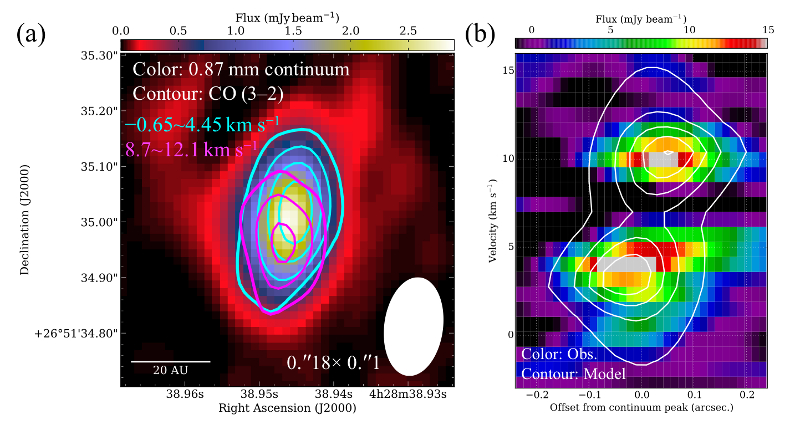
|
EPoS |
|
EPoS Contribution
|
|
A Detached Protostellar Disk around a ~0.2Msun Protostar in a Possible Site of a Multiple Star Formation in a Dynamical Environment in Taurus
Kazuki Tokuda OPU/NAOJ, Sakai, JP | |
| We report ALMA Cycle 3 observations toward a very low-luminosity (<0.1 Lsun) protostar, which is deeply embedded in one of the densest cores, MC27/L1521F, in Taurus. Our previous ALMA observations with an angular resolution of ~1"(~140 au) revealed the complex envelopes, such as arc-like structures and a few starless condensations, around the protostar. These results suggest that the initial condition of (multiple) star formation can be highly dynamical. Although the ALMA observations provided us the significant information that we have not seen with the previous instruments, further investigations were needed to understand the overall picture of this complex system. In particular, the evolutionary status of the very low-luminosity protostar is still unclear, possibly due to insufficient spatial resolutions. The beam size of the present observations corresponds to ~20 au, and we have clearly detected compact blueshifted/redshifted gas in 12CO associated with the protostar. The spatial/velocity distributions of the gas show there is a rotating disk with a size scale of ~10 au, a disk mass of ~10-4 Msun, and a central stellar mass of ~0.2 Msun. The observed disk seems to be detached from the surrounding dense gas, although it is still embedded at the center of the core whose density is ~106 cm-3. The current low-outflow activity and the very low luminosity indicate that the mass accretion rate onto the protostar is extremely low in spite of a very early stage of star formation. We may be witnessing the final stage of the formation of ~0.2 Msun protostar. However, we cannot explain the observed low luminosity with the standard pre-main-sequence evolutionary track unless we assume cold accretion with an extremely small initial radius of the protostar (~0.65 Rsun ). The highly dynamical (turbulent) environment seen in this system may be a hint to understand the formation of the detached disk. The present 12CO (J = 3-2) observations also shows a hint of shock in the dense core possibly caused by interactions of the turbulent gas. These facts may challenge our current understanding of the low mass star formation, in particular the mass accretion process onto the protostar and the circumstellar disk. | |
 | |
| Caption: Dust/gas distributions of a very low-luminosity protostar, MMS-1(L1521F-IRS) with ALMA. (a) Color-scale image shows the distribution of 0.87 mm continuum. Cyan and magenta contours show blueshifted and redshifted components of 12CO (J = 3-2), respectively. (b) Color-scale image showing a 12CO (J = 3-2) P-V diagram of the ALMA observation along the major axis of the disk. Contours show that of the simulated Keplerian model with Mstar = 0.18 Msun. | |
| Collaborators: T. Onishi, OPU, JP K. Saigo, NAOJ, JP T. Hosokawa, KU, JP T. Matsumoto, HU, JP S.-I. Inutsuka, NU, JP M.N. Machida, KU, JP K. Tomida, OU, JP M. Kunitomo, TU, JP A. Kawamura, NAOJ, JP Y. Fukui, NU, JP K. Tachihara, NU, JP |
Key publication
Suggested Session: Protostellar disks |